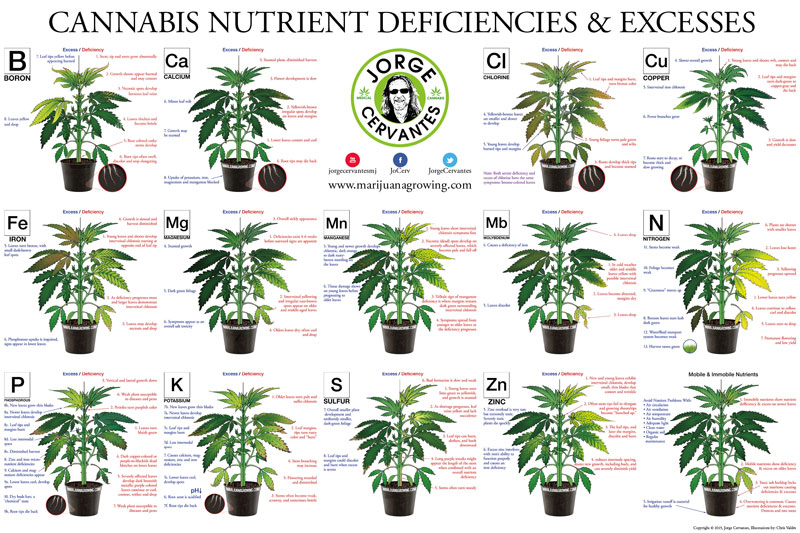Introduction
Cleanliness is the secret to disease and pest prevention. Keep the floor, ground, and substrate surface clean. Dirty tools often carry microscopic pests and diseases. Wearing clean clothes and using clean tools will reduce problems. A separate set of indoor tools is easy to keep clean.
Wash your hands if you touch diseased plants. Pay attention to simple hygiene. Do not work in the dirty outdoor garden and then visit the indoor garden. Even walking across a lawn or brushing up against outdoor plants could carry pests and diseases to your indoor garden. Stay away from dogs, cats, and other pets that have been outdoors, and don’t let them in the garden. Houseplants can also help spread pests and disease.
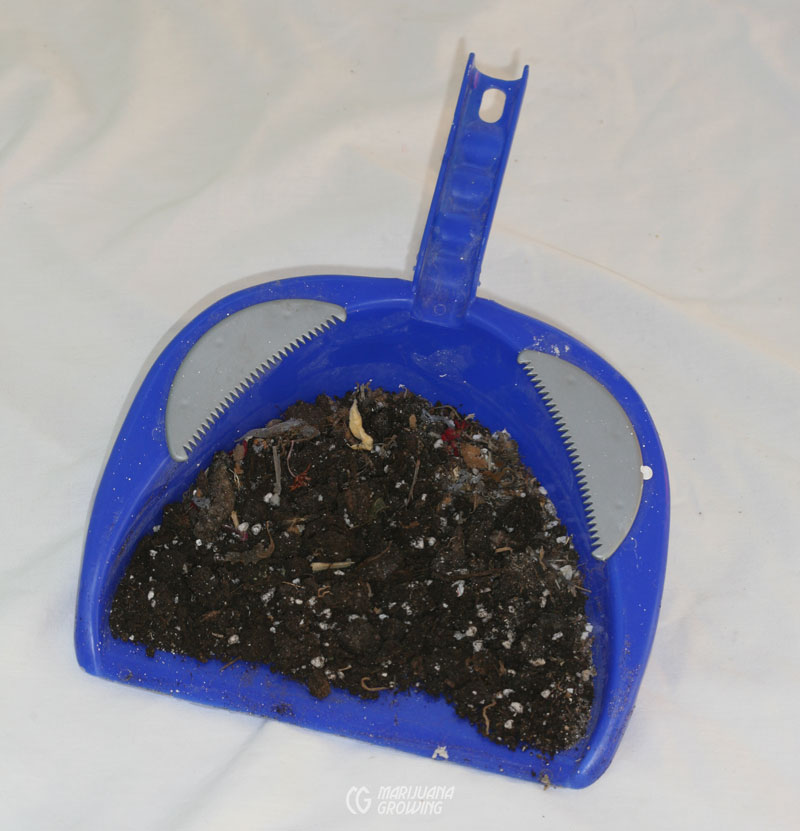
Keep all debris off the floor. Clean the garden area regularly.
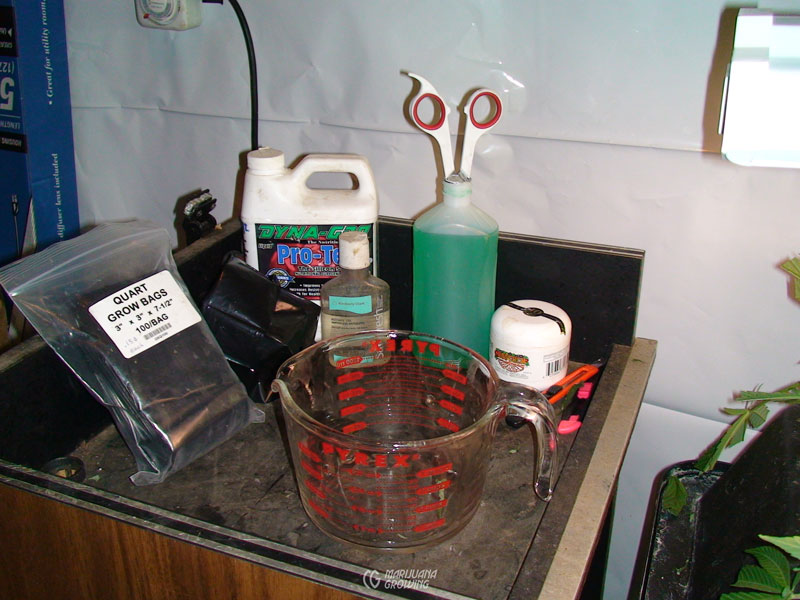
Dip tools in alcohol to disinfect.
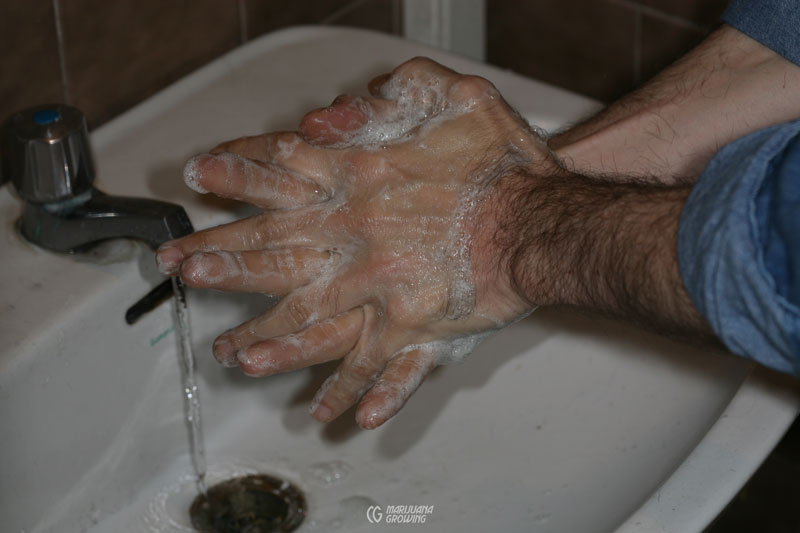
Wash your hands to avoid transmitting insects and diseases from other plants.
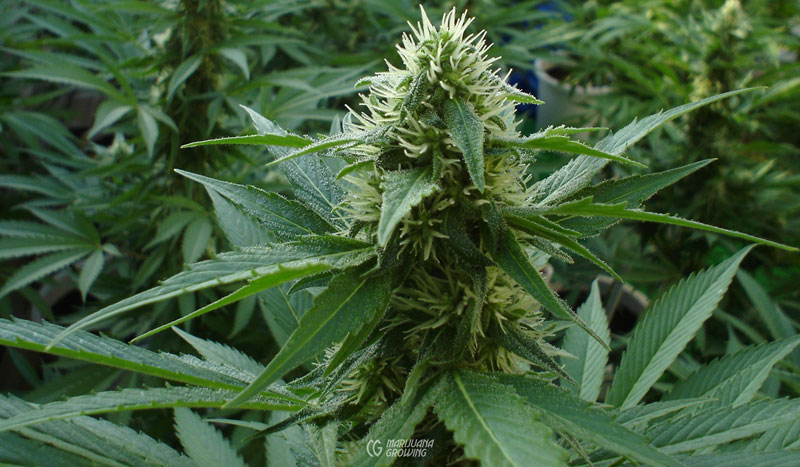
Grow insect- and fungus-resistant strains like Power Plant and keep the garden strong and healthy. Keep air well-circulated and fresh. Keep humidity around 50% and maintain the temperature at about 75°F (24°C) during the day and about 5°F (3°C) cooler at night.
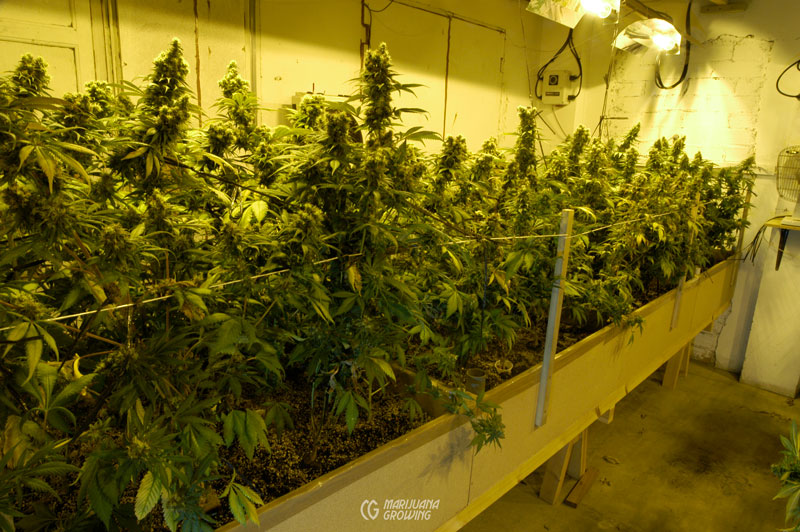
Keep the temperature and humidity at the proper levels to avoid cultural, pest, and disease problems.
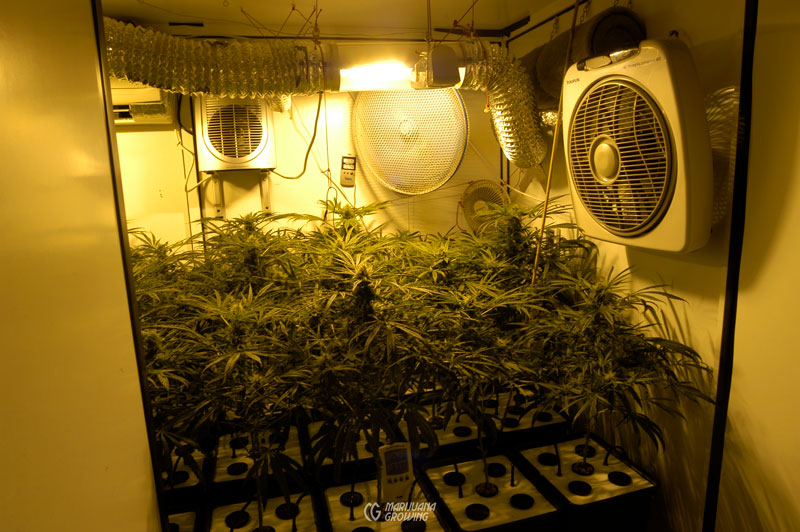
Make sure there is plenty of ventilation and air circulation.
Misdiagnosed Disorders
Avoid most common ailments by keeping light, temperature, and humidity at the proper levels. Use clean water, the proper complete nutrient solution, maintain EC and pH at the correct levels, and change the nutrient solution every week. Fine-tune these vital factors before deciding that plants are nutrient deficient.
Many problems in containerized gardens and to a lesser degree outdoor gardens, are misdiagnosed as a lack or excess of fertilizer. Inexperienced growers tend to solve nutrient concerns by adding fertilizer rather than learning the cause of the problem and solving it. Often, adding more fertilizer compounds and complicates cultivation problems.
Once a plant demonstrates symptoms, it has already undergone stress. It will take time for it to resume vigorous growth. Correct identification of each symptom as soon as it occurs is essential to help plants retain vigor. Indoor, greenhouse and some outdoor marijuana crops live a short three or four months and are harvested so fast that plants do not have time to recover from nutrient imbalances. One small imbalance could retard growth by a week or more and diminish harvest.
Light is often a problem indoors. Low levels of light and light of the wrong color spectrum causes slow growth. When growth is slow, diseases and pests tend to attack weaker plants. Nutrient deficiencies and excesses also tend to develop quickly.
Indoors, the proper LED lights supply the perfect spectrum and intensity for cannabis growth. Mounting height of the light fixture and even coverage of intense light are essential. Check with light manufacturers for mounting height and light coverage.
Too much light is seldom a problem. Intense light from HID lights radiates a good deal of heat. When mounted at the proper height the light footprint spreads evenly.
Air temperature and humidity also influence growth. Keep the temperature in the range of 70°–75°F (21°–24°C) day and about 65°–70°F (18°–21°C) night. Keep relative humidity 55–65% vegetative room and 50% flowering room. The humidity climbs at night when the lights go out and temperatures drop. Typically, venting moist air out of the room will keep humidity in the proper range.
Circulation fans keep the air from stratifying, hot air rises and cooler air lays near the ground. Circulating air moves foliage and creates a more difficult to attack plant.
Ventilation fans keep air changing in the grow room. Control heat and humidity with ventilation. Turn the ventilation fan on to evacuate hot humid air. New fresh air will replace old stale air to keep plants healthy.
Water quality – Raw input water with a dissolved salt reading greater than 300 ppm is often treated with a Reverse Osmosis (RO) device to remove the excess salts. RO-treated water is ideal because it has virtually no dissolved salts. You add all the nutrient salts to form a perfect nutrient solution. RO devices also remove sodium from the water. Excess sodium (more than 50 ppm) in the water supply restricts water and nutrients from being absorbed by the roots.
Over-watering is a common problem. Too often gardeners kill containerized plants with kindness, too much water and often fertilizer. Use a moisture meter with a probe to check substrate moisture levels.
Underwatering occurs when the substrate is not completely wet. Water never reaches the dry substrate. A moisture meter will help avoid under-watering and help you find dry soil pockets that do not get watered in the container.
An imbalanced pH causes problems. The pH of input water can be about 7.0 because fertilizers are acidic and drop the pH of the final nutrient solution. Keep the pH adjusted in the range of 5.5–6.5, in hydroponics, and 6–6.5 in soil gardens to allow nutrients to be chemically available.
The optimum pH range for cannabis growth is 5.8- 6.2. But cannabis plants will grow within a pH range of 5.5-6.5. Within this range, nutrients are chemically available in solution; above or below this range, several nutrients become less available. And, different substrates, coco coir, rockwool, soilless mix, expanded clay pellets, all have specific air and moisture needs to ensure nutrients are available. In soil, a pH below 6.5 may cause a deficiency in calcium, which causes root tips to burn and leaves become subject to fungal infections and dead spots on foliage. A pH above 7.0 could slow down the plant’s iron intake and result in chlorotic leaves causing veins to yellow. Adding more calcium and iron will not solve the problems.
Nutrient deficiencies and excesses can also be confused with disease and pest damage. For example, Hemp Russet mites cause slow growth and small deformed flower growth. Inexperienced growers may confuse this with a nutrient problem.
Over-fertilizing is common. Adding too much fertilizer without sufficient runoff causes nutrient salts to build up in the substrate, creating toxic conditions. Nutrient excesses and nutrient deficiencies occur that are caused by toxic levels of fertilizer in the substrate.
Under-fertilizing is less common. But using the wrong measuring scale/container or misinterpreting the mixing formula is somewhat common. Always double check the proportions of nutrients to be mixed into solution.
Poor drainage, cold, soggy soil impairs nutrient uptake and leads to root rot. Tell tale signs of these conditions include weak, supple, discolored, and super green foliage.
Soil temperature should be kept below 65ºF (18ºC) so that nutrients are readily available for uptake. Hot soil impairs nutrient uptake by roots and causes excessive water consumption. Outward signs include discolored foliage, dry foliage and hot soil.
Damage from cultural practices
| Cultural Practice | Symptom |
| Lack of light | slow, spindly growth and stretching between internodes |
| Light burn | burned patches on leaves |
| Lack of ventilation to the plant | slow growth and curled-down leaves |
| High humidity | slow growth and curled-down leaves |
| Low humidity | seldom a problem and plants use more water |
| High temperature | slow growth and drooping leaves |
| Low temperature | slow growth, purpling, and no flowers |
| Over-watering | slow growth, disease and nutrient deficiencies |
| Under-watering | wilting, slow growth, disease and nutrient deficiencies |
| Nutrient pH | slow growth, poor nutrient uptake, discolored foliage |
| Nutrient overdose | slow growth, dry foliage, burned and discolored foliage |
| Soil has nutrient buildup | slow growth, burned and discolored foliage |
| Poor drainage | slow growth, curled down leaves |
| Indoor air pollution | slow growth and sickly appearance |
| Spray application damage | burned spots |
Nutrient Deficiencies & Excesses
You may have seen this infographic before. I made it about 10 years ago for the Cannabis Encyclopedia. Since then, it has been copied many, many times. If you should decide to copy it, please copy “as is” without removing my name and website. Thanks!
Diseases & Pests
This section covers the most common pests and diseases that attack cannabis plants in a grow room. The descriptions and methods of control are simple and straightforward. If you have more questions about pests and diseases not answered in this book, please consult Marijuana Horticulture: The Indoor/Outdoor Medical Grower’s Bible, which covers in much more detail solutions to controlling just about any pest and disease that attacks cannabis.
Controlling diseases and pests requires a multifaceted approach.
1
Keep all debris off the floor. Clean the garden area regularly.
2
Wash your hands to avoid transmitting insects and diseases from other plants.
3
Dip tools in alcohol to disinfect.
4
Grow insect- and fungus-resistant strains and keep the garden strong and healthy.
5
Keep air well-circulated and fresh.
6
Keep humidity around 50% and maintain the temperature at about 75°F (24°C) during the day and about 5°F (3°C) cooler at night.
7
Inspect plants every day/week for signs of diseases and pests.
Spider Mites
Spider mites are common indoors. Find spider mites on leaf undersides, sucking plant fluids. They look like tiny specks and cause yellowish-white spots on the tops of leaves. If infested, spider webs may be seen when misted with water. A 10X–30X magnifying glass helps to identify the yellow, white, two-spotted, brown, or red mites and their translucent eggs.
Control spider mites by:
• Cleaning up regularly
• Raising humidity and lowering temperature
• Smearing sticky trap such as Tanglefoot™ around the pot lip and stems
• Dipping small plants and spraying large ones with pyrethrum or neem oil
• Introducing predatory mites
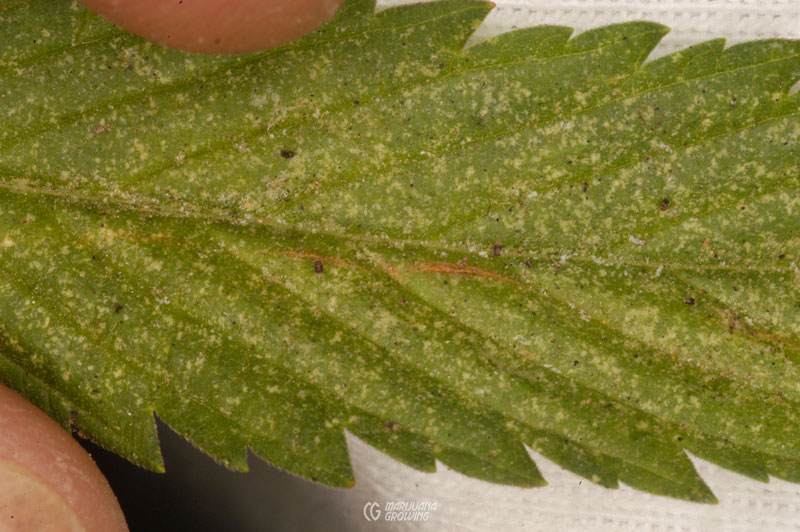
Stipples caused by mites.
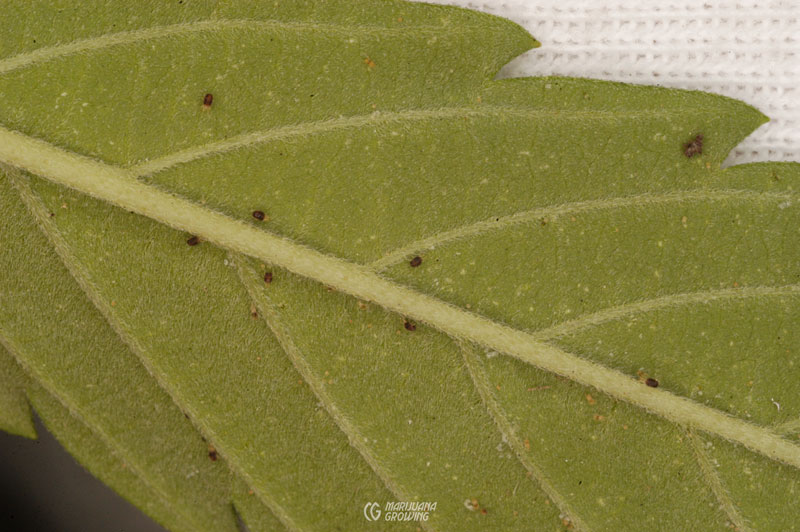
Mites on leaf underside.
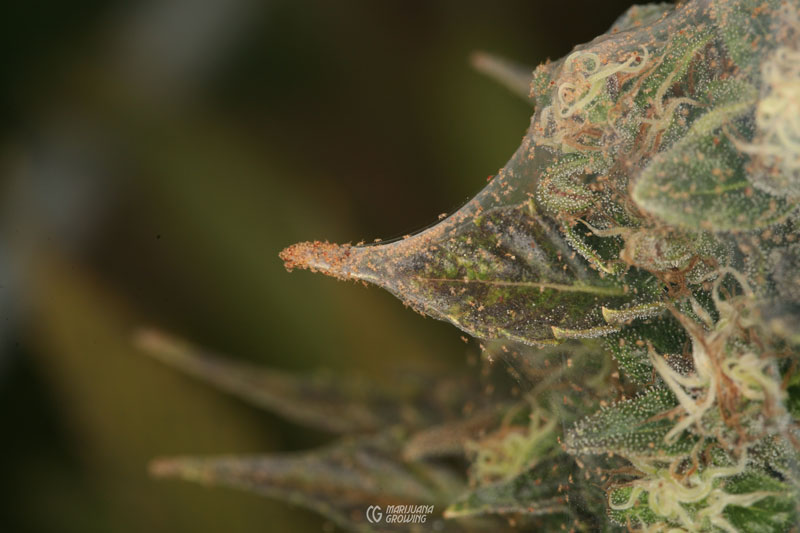
Spider mite infestation! Parts of this plant are completely covered with spider mite webbing. It is better to remove an infested plant from the garden so that it does not contaminate other plants.
Whiteflies
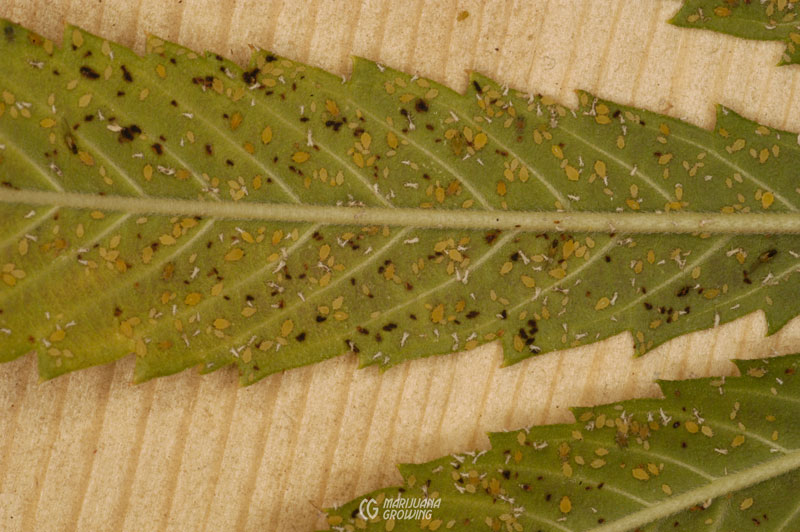
Whiteflies flutter from under leaves when disturbed. They look like a small, white moth about one millimeter long. Adults have wings. Eggs are also found on leaf undersides. Whiteflies cause whitish speckles, stipples, on the tops of leaves. Attract and kill adults with bright yellow sticky traps that are placed among plants. The wasp Encarsia formosa is the most effective whitefly parasite. Kill with insecticidal soap or pyrethrum applied at five- to ten-day intervals.
Whiteflies are between yellowish aphids. The dark spots are honeydew that has attracted mold.
Fungus Gnats
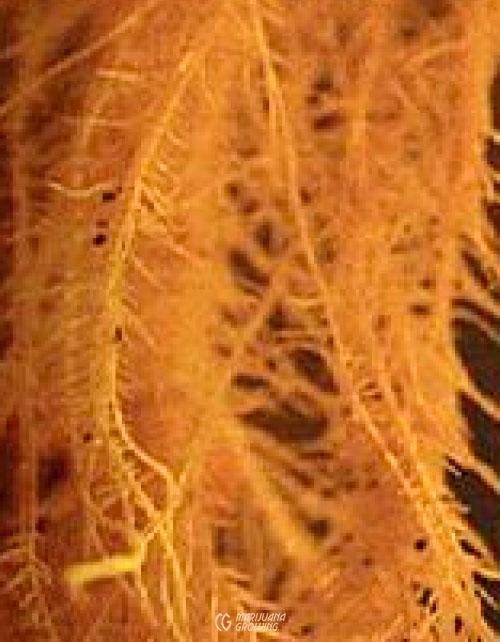
Dark specks are fungus gnats. Larvae grow four to five millimeters long with translucent bodies and black heads. Winged adults are gray to black with long legs. Pests infest growing mediums and roots, eating and scarring roots. Plants lose vigor, foliage pales, and wounds invite disease. Control with Vectobac®, Gnatrol® and Bt-i. Use neem or insecticidal soap as a soil drench. Predatory soil mites are also available.
Gray Mold (Botrytis)
Gray mold (aka bud mold and bud rot) flourishes in moist, temperate climates and can be fatal. Botrytis appears hairlike, similar to laundry lint, and later turns slimy but can appear as dark, brownish spots on stems and flowers in arid climates. It attacks stems, leaves, and seeds, and can cause damping-off.
Once it starts, gray mold is fatal. If on buds, cut buds off one inch (3 cm) below infestation. Prevent gray mold by increasing air circulation and ventilation. Use fresh, clean growing medium. Remove infected foliage with alcohol-sterilized pruners and destroy it. Wash your hands and tools.
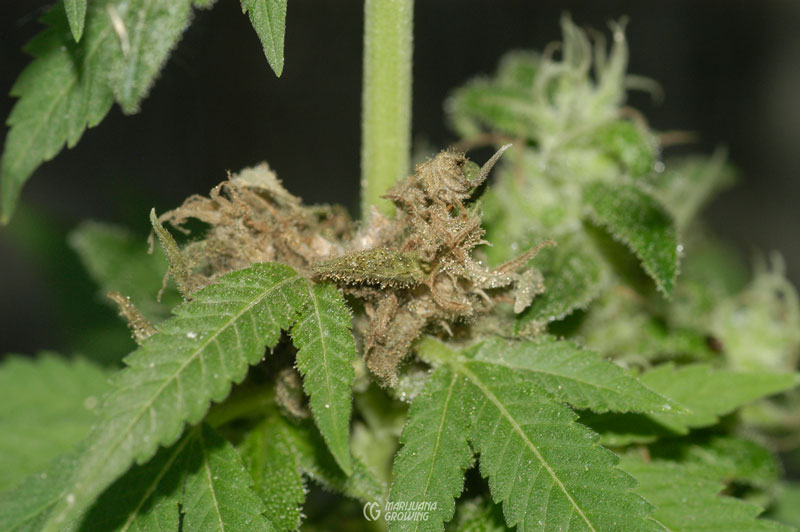
Gray mold on bud
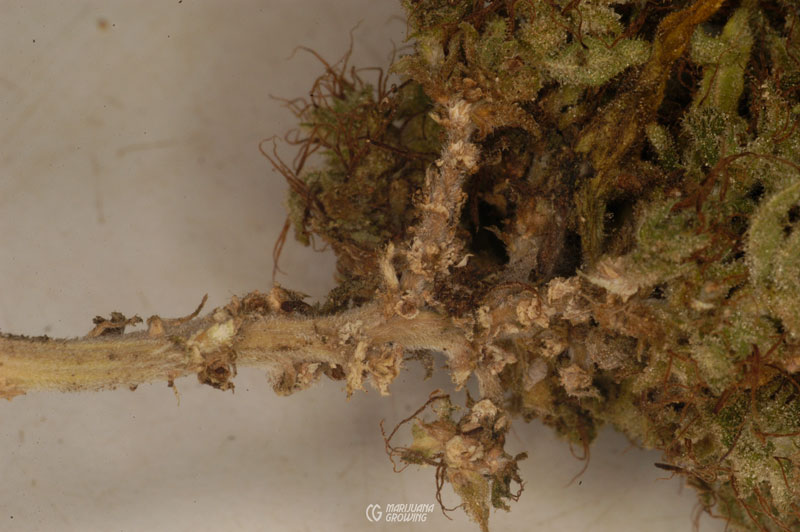
Botrytis damage
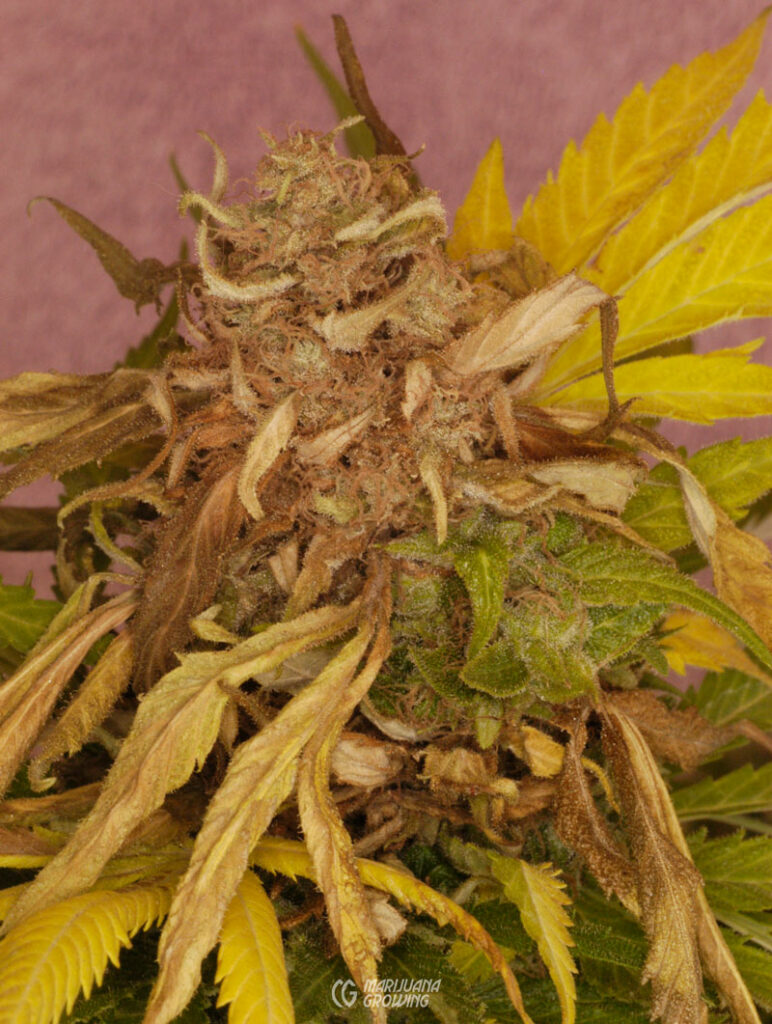
This bud is gone!
Damping-off
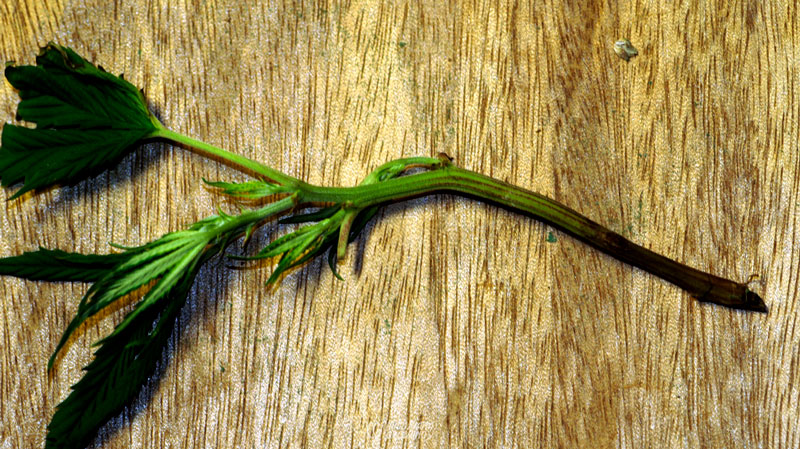
Rotten stem
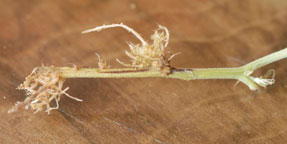
Damaged stem and roots
Damping-off is fatal. It prevents sprouted seeds from emerging. Seedlings and cuttings rot at the soil line. Foliage in older plants yellows and stems rot. First, the stem loses girth at the soil line, grows dark, and finally falls over.
Once it starts, damping-off kills plants. Avoid by controlling growing-medium moisture. Dust seeds with fungicide.
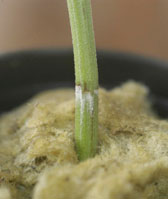
Damping-off rots seedlings and cuttings at the soil line.
Green Algae
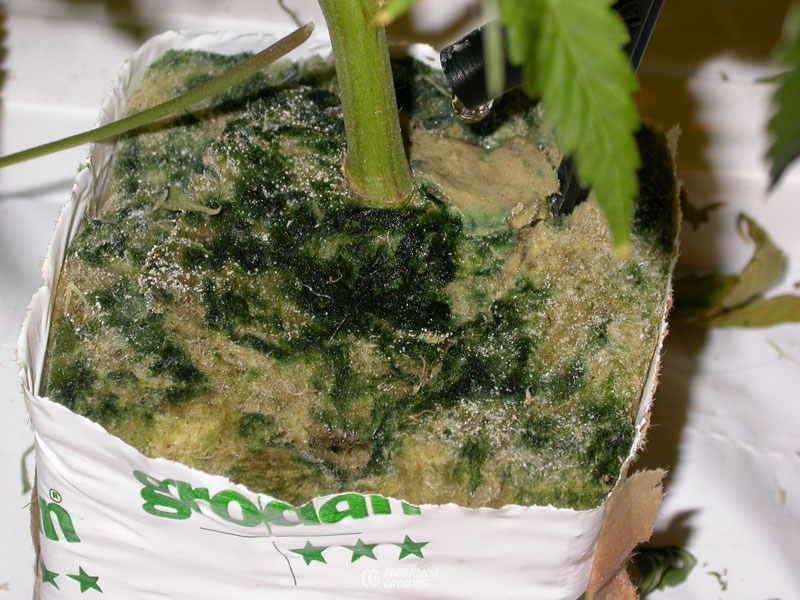
Green algae grow in light and nutrient-rich environments. Avoid algae by covering growing mediums.
Slimy, green algae need nutrients, light, and a moist surface to grow. Algae grow on moist rockwool and other moist-growing mediums exposed to light. Algae cause little damage, but attract fungus gnats and other pests and diseases.
Prevent by covering moist-growing mediums to exclude light. Control by adding an algaecide to the nutrient solution.
Downy Mildew
Sometimes called “false mildew,” downy mildew affects vegetative and flowering plants. It appears as whitish-yellow spots on top of leaves, creating pale patches. Greyish mycelium spawn is on leaf undersides, opposite the pale patches.
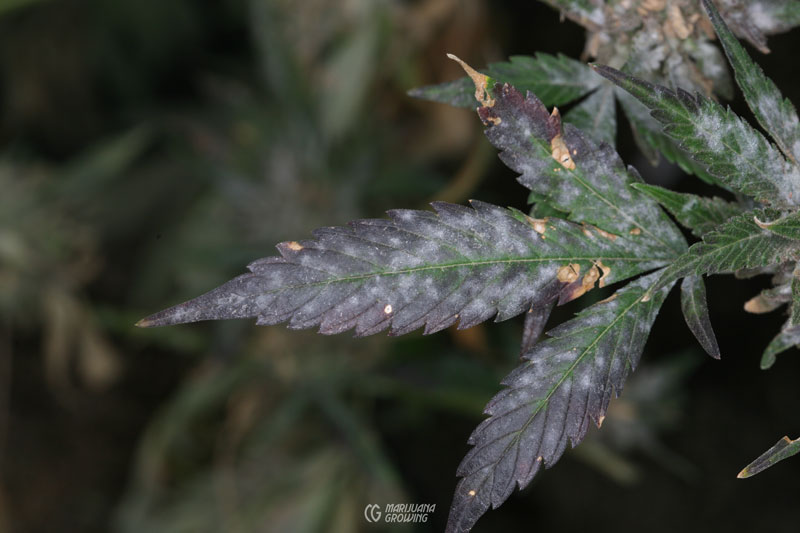
Control with cleanliness! Use a sterile growing medium. Remove and destroy affected plants, not just foliage. Kill with biological Serenade® and the Bordeaux mixture (copper sulphate and hydrated lime) is also somewhat effective.
Root Rot
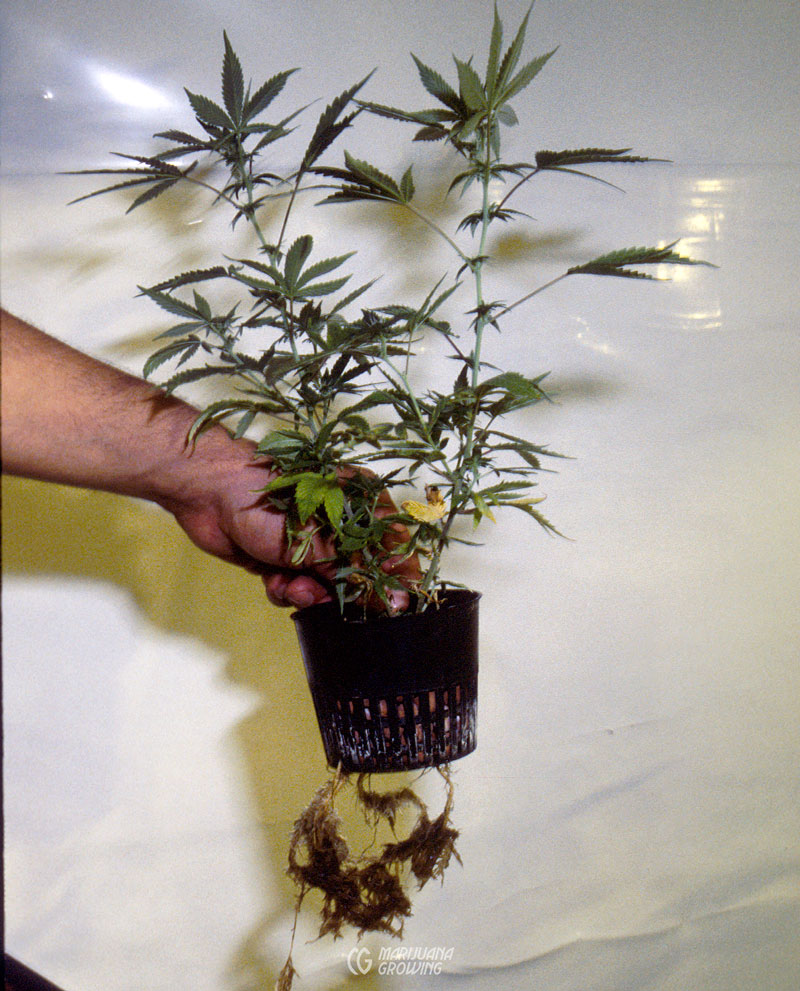
Root rot causes roots to turn brown and slimy.
Root rot turns roots dark brown, slows growth, leaves discolor, older foliage and later the entire plant wilts. Root rot is caused by lack of air and soggy substrate.
Root rot causes roots to turn brown and slimy.
Prevent root rot by using fresh, sterile growing medium and keeping the garden clean. Keep calcium levels adequate and avoid excess nitrogen. Keep pH above 6.0 in hydroponic units, and use Bio-Fungus® or RootShield®. Root rot causes roots to turn brown and slimy.
Spraying Cannabis
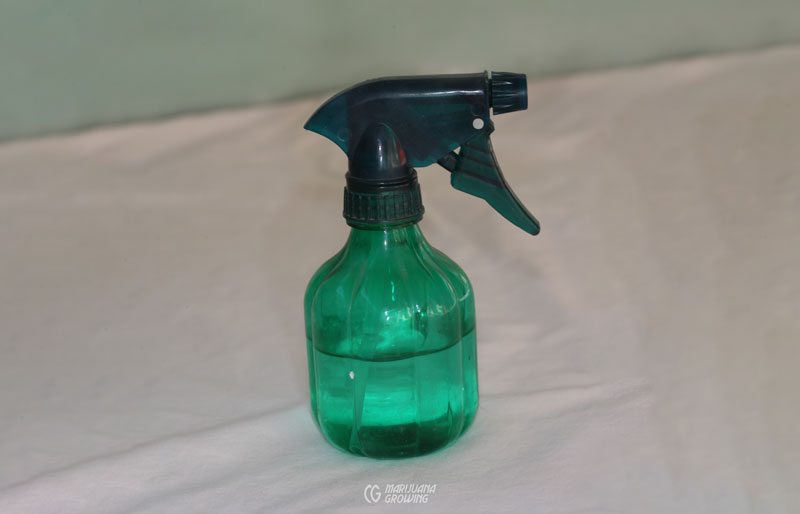
Small pump hand sprayers are convenient and economical.
Pests and diseases can often be avoided by making sure the garden area is clean. Inspect foliage and roots regularly for signs of pests and diseases.
Control the growing environment to ensure plants are strong and healthy. Sometimes even with the best intentions, pests and diseases get a grip in the garden and must be removed.
Once you have determined you must spray, assess the damage and identify the pest or disease. Once identified, you can take cultural measures or purchase the proper product to rid the garden of the plague.
• Use only contact sprays approved for edible fruits and vegetables
• Do not use toxic systemic chemicals!
• Read the entire label on all sprays and follow Directions
• Mix pesticides and fungicides just before using
• Safely dispose of unused spray
• Organic and natural-based sprays are also toxic and should be used sparingly
• Spray both sides of leaves and stems
• Rinse leaves on both sides with plain water 24 to 48 hours after spraying
• Use protective gear, including a facemask, when spraying, especially if using an aerosol/fogger
• Raise lamps up and out of the way
Small pump hand sprayers are convenient and economical.

Jorge Cervantes (left) wore disguise for 20 years to avoid arrest.
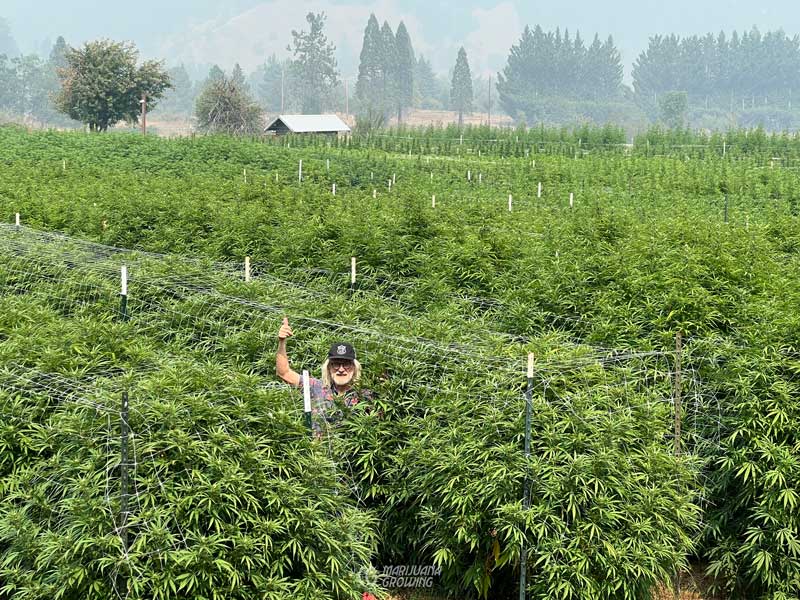
Today, Jorge waves to you from a legal garden in Southern Oregon.


